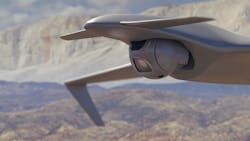Air Force researchers focus on meta optics for small, inexpensive electro-optical sensors in small UAVs
WRIGHT-PATTERSON AFB, Ohio – U.S. Air Force researchers are asking industry to develop advanced-technology inexpensive electro-optical sensors for small disposable unmanned aerial vehicles (UAVs).
Officials of the Air Force Research Laboratory at Wright-Patterson Air Force Base, Ohio, released a presolicitation on Monday (FA8650-22-S-5009) for the Low-Cost Optical Systems Technology (LOW-COST) project.
The size and weight on onboard infrared and visible-light sensors make their integration on small UAVs difficult; conventional optics have several stages and occupy much more volume than the lenses themselves.
For these kinds of sensors, the optics are held in place by a supporting structure that maintains the alignment of the optical elements. Often there are tradeoffs between volume and weight, size and performance, and complexity/cost.
Related: Navy asks industry to develop inexpensive focal plane arrays for small systems like UAVs
High-performance electro-optics typically are complex, costly, and can stretch size constrains in small UAVs. The use of meta optics, however, has the potential to yield relatively small and high-performance infrared sensors, thanks to flexible optical system design and component manufacturing.
Meta optics, or metalenses, is a new flat lens technology for sensing and imaging in unmanned vehicles, augmented-reality displays, and consumer electronics.
Air Force researchers are looking to apply new optical technologies to compact infrared and visible-light sensors for attritable and low-cost, small, unmanned aircraft.
The Low-COST program seeks to reduce the cost, size, and weight of optical systems in small UAVs operating in combat conditions by using meta optics to realize increased system performance through hybrid and planar optic systems.
Enabling configurable meta optic systems to work with computational imaging and image processing is expected to demonstrate increases in system performance outside of imaging applications is a primary goal of the program.
This will provide a new capability for active and passive infrared and visible-light sensors on small and attritable UAVs and provide autonomous sensing capabilities such as incoming missile warning, laser warning, and infrared search and track (IRST). These capabilities currently do not exist at costs, sizes, and weights small enough for small UAVs and attritable platforms.
Related: Probing what the human eye cannot see
This is a pre-solicitation notice only, and a broad agency announcement with more details for this program may be released in February or March 2022. Air Force researchers say two contractors ultimately may share as much as $2.7 million on this project through 2025.
Researchers are not asking for any proposals yet. Email technical questions or concerns to the Air Force's Joseph Burns, the LOW-COST program manager, at [email protected], and contracting questions to Mark Merrifield at [email protected].
More information is online at https://sam.gov/opp/06deb11ae09c481486f5a8431424b5bd/view.

John Keller | Editor-in-Chief
John Keller is the Editor-in-Chief, Military & Aerospace Electronics Magazine--provides extensive coverage and analysis of enabling electronics and optoelectronic technologies in military, space and commercial aviation applications. John has been a member of the Military & Aerospace Electronics staff since 1989 and chief editor since 1995.

